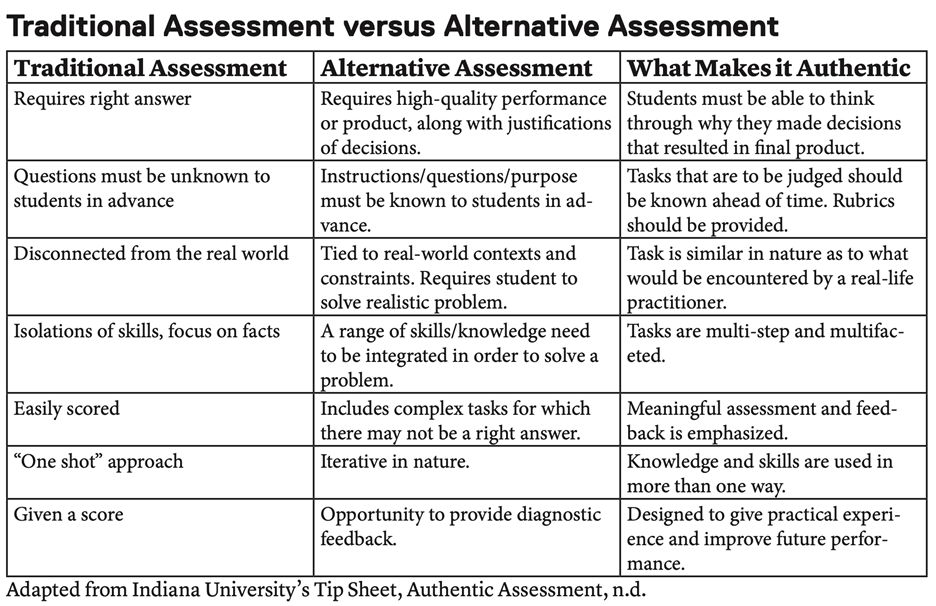Office of the Provost–Division of Faculty Success
Trinity Hall 106, 800 Greek Row Dr., Box 19128
The University of Texas at Arlington
Arlington, TX 76019
Phone: 817-272-7464 | Email: CRTLE@uta.edu
Alternative Assessments
Alternative or Authentic Assessments
Student’s Experience with Alternative Assessments
During my time at UTA, I’ve had the fortune to experience many different forms of teaching from various academic disciplines. While each discipline has their own teaching methodology, the ones where I remember the skills and concepts the most (even after a couple years) are the ones that utilized alternative assessments.
I found cramming for a 60-question exam was not helping me learn the course material as much as me trying to present my poster presentation in front of my peers. By being able to focus on the quality of the work I was putting into projects, essays, or presentations, I was learning how to apply the newly learned skills rather than trying to remember it for a timed exam.
Having alternative forms of assessments allow for the work library to expand for students. Rather than just having a GPA or a list of courses I’ve taken, having a portfolio with work helps to show what I can do rather than trying to advocate for my skills on a resume.
Definition
an alternative to standard tests and exams, provide a true evaluation of what the student has learned, going beyond acquired knowledge to focus on what the student has actually learned by looking at their application of this knowledge.

Approaches to Alternative Assessments
- Use multiple forms of assessment that align with learning goals in each unit
a. Allows for a more comprehensive and accurate representation of a student’s learning - Consider eliminating midterms and/or final exams
a. Shorter, more frequent, and varied assessments are a better way for students to solidify concepts and skills - Allow students to self-assess and engage in peer review and revision with possible
a. Replicates the kind of work they will do in their careers - Revise late work and “zero” policies
a. Student will never be able to achieve a passing grade if they have a couple zeroes on their record; this allows for holding the students accountable for doing their work, even if it is late - Allow students to do test corrections to show they understand their mistakes
a. Lets students understand what they got wrong and can demonstrate that they know how to correct their errors - Refrain from grading the first assignment(s) each semester
a. Lowers stress and allows students to focus on the learning instead of just the grade - Diversity teaching strategies to include rigorous project/problem-based learning as part of each unit
a. Assignments can mimic the kind of learning and assessment that takes place outside the classroom
Types of Alternative Assignments
|
Letter/Letter to the editor |
Requires research disciplinary knowledge, communication skills and creativity |
|
Memo |
Allows the student being concise and direct |
|
Presentations |
Enhances professional verbal, visual, and written communication skills |
|
Poster Presentation |
Teaches professional skills for participation in academic conferences |
|
Portfolio of Work |
Demonstrates the evolution of their work over the course of the semester |
|
Proposals |
Allows students to try out their ideas and set their own goals for learning before actually carrying out the projects |
|
Policy Briefs, Reports |
Allows students to develop professional skills and become familiar with the specific vocabulary and style of writing in their fields |
|
Case students, Stimulations |
Students must apply higher order thinking skills in order to evaluate and apply knowledge, and to analyze the problem |
|
Fishbowls |
Advances the student knowledge and comprehension, improves skills in active listening, critical inquiry, professional communication, presentation, and group discussion |
|
Observations |
Allows for a real world application from what was taught in the classroom. |
|
Interviews |
Advances the student critical thinking, being concise, and allows for personal experience of being interviewed |
|
Performance tasks |
Allows students to develop professional skills and become familiar with the specific vocabulary |
|
Exhibitions and demonstrations |
Teaches professional skills for participation in academic conferences/ relevant disciplines |
|
Journals |
Allows for self-reflection and a written record of the student’s academic progress |
|
Teacher-created Tests |
Allows for the material to be more familiar with what is taught inside the classroom |
|
Rubrics |
Provides the student with the exact specifications of what will be expected upon them |
|
Self- and peer- evaluation |
Allows for feedback and revision to be prioritized |
References
- https://www.ryerson.ca/content/dam/learning-teaching/teaching-resources/assessment/alternative-assessments.pdf
- https://www.edutopia.org/assessment-guide-description
- https://www.ascd.org/el/articles/7-approaches-to-alternative-assessments